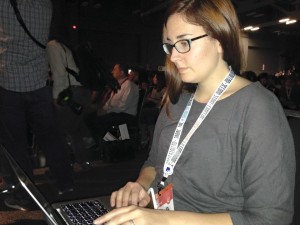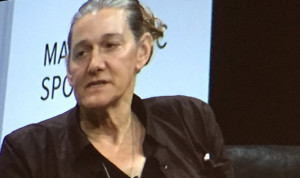 In the months before SXSW, I prepared.
In the months before SXSW, I prepared.
I prepared to be overwhelmed with my choices. With hundreds of panels to choose from and more than 30,000 attendees alongside me making the same choices, I prepared to be jostled, shut-out and waylaid. I knew I might have to change my plans at a moment’s notice.
I prepared to be overwhelmed with my work. Coming from a non-journalistic background, Interactive would be my first time covering an event. The idea of approaching strangers with questions made me distinctly uncomfortable. The idea of turning over content quickly, almost more so.
I prepared to be hungry – my backpack’s small compartments were filled with granola bars and bananas. I prepared for my feet to hurt, running back and forth between venues. I prepared for rain and heat. I prepared to always, always, always be charging my many devices whenever a free outlet caught my eye.
What I did not prepare for was the incredible swell of energy, positivity and enthusiasm that overtook the entire conference.
I wasn’t overwhelmed. I was buoyed by the tangible excitement for this opportunity to escape the everyday and venture into the “what if…?”
I wasn’t uncomfortable. Every single person I met or questioned was not just willing, but eager, to talk about his project, her hopes, her take on some related topic. I had the feeling that almost as much as the panels, this was why people came: to meet and talk and express.
I certainly wasn’t hungry. Austin’s famed food truck scene outdid itself to show the city’s visitors, in their way, that Austin was at the heart of SXSW.
What I was: Inspired – and always, always, always charging my many devices when I happened upon a free outlet.
Everyone had ideas. And these weren’t the kinds of ideas you have when you’re on assignment or when your boss expects a solution. Every panel was filled with out-of-the-box, let’s-completely-rethink-this, we-don’t-even-know-if-this-COULD-work-but-how-incredible-would-it-be-if-it-did-work ideas.
And the topic I heard rehashed, rethought and re-examined the most seemed to be diversity.
Diversity was a huge theme for SXSW Interactive this year. It’s historically been a problem for STEM focused jobs and industry and an enormous number of panelists spoke to the experiences they’ve had, either as diverse technologists themselves or as a part of the effort to increase diversity in their field.
Three of the conference’s five keynotes referenced diversity in some form. There was a focus on women in the workforce with Princess Reema of Saudi Arabia:
"judge women on their capabilities not on their appearance." @rbalsaud at #sxsw #sxtxstate #empower
— Rebecca Larson (@beckslarson) March 14, 2015
 There was a tangential reference to diversity in the third keynote of the event: Martine Rothblatt, the highest paid female, and transgender, CEO in the country, spoke about her transhumanist beliefs and the difference our compassion and understanding will make in leading us toward utopian or dystopian futures.
There was a tangential reference to diversity in the third keynote of the event: Martine Rothblatt, the highest paid female, and transgender, CEO in the country, spoke about her transhumanist beliefs and the difference our compassion and understanding will make in leading us toward utopian or dystopian futures.
And in the final keynote, a broad message of encouragement during Astro Teller’s address on Google[x]’s “Moonshot” projects.
Diversity is something people throw out like a tip at a restaurant – this is something we work really hard on. @astroteller #sxsw #moonshots
— Rebecca Larson (@beckslarson) March 17, 2015
Working w/ people who look just like you and think just like you is not going to help you succeed. @astroteller #sxsw #SXTXState #moonshots
— Rebecca Larson (@beckslarson) March 17, 2015
While the keynotes focused on individual initiatives or broad we-need-to-do-this imperatives, there were many panels during Interactive examining the intricacies that make up the problem of diversity in STEM.
Panels covered the issue of encouraging girls in STEM fields in childhood. They talked about the state of diversity as it stands now, where female or ethnic minority names will often disqualify a resume even if the skills and experience listed are well-suited for a job. They asked whether it was a pipeline issue or a lack of relatable role models.
Almost all the speakers who referenced diversity added that they didn’t know the solution to the problem. They said there probably wasn’t just one solution.
But the sheer number of people stepping forward to say that diversity is something necessary was incredible. Women, men, people from all cultural backgrounds. Large brands, solo speakers. Whether the message was cultural responsibility, or the best path to success and profit, all roads led to a future where diverse voices come together for common goals.
In the end, it was that sense of common goals that defined my SXSW experience, that regardless of the paths we take, we are all in this together.
